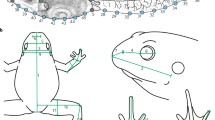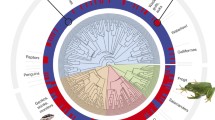Abstract
The evolution of sexual dimorphism is an important topic of evolutionary biology, but few studies have investigated the determinants of sexual dimorphism over broad phylogenetic scales. The number of vertebrae is a discrete character influencing multiple traits of individuals, and is particularly suitable to analyze processes determining morphological variation. We evaluated the support of multiple hypotheses concerning evolutionary processes that may cause sexual dimorphism in the number of caudal vertebrae in Urodela (tailed amphibians). We obtained counts of caudal vertebrae from >2,000 individuals representing 27 species of salamanders and newts from Europe and the Near East, and integrated these data with a molecular phylogeny and multiple information on species natural history. Per each species, we estimated sexual dimorphism in caudal vertebrae number. We then used phylogenetic least squares to relate this sexual dimorphism to natural history features (courtship complexity, body size dimorphism, sexual ornamentation, aquatic phenology) representing alternative hypotheses on processes that may explain sexual dimorphism. In 18 % of species, males had significantly more caudal vertebrae than females, while in no species did females have significantly more caudal vertebrae. Dimorphism was highest in species where males have more complex courtship behaviours, while the support of other candidate mechanisms was weak. In many species, males use the tail during courtship displays, and sexual selection probably favours tails with more vertebrae. Dimorphism for the number of tail vertebrae was unrelated to other forms of dimorphism, such as sexual ornamentation or body size differences. Multiple sexually dimorphic features may evolve independently because of the interplay between sexual selection, fecundity and natural selection.
Similar content being viewed by others
References
Allen, C. E., Zwaan, B. J., & Brakefield, P. M. (2011). Evolution of sexual dimorphism in the Lepidoptera. Annual Review of Entomology, 56, 445–464.
Arakelyan, M. S., Dalielyan, F. D., Corti, C., Sindaco, R., & Leviton, A. E. (2011). Herpetofauna of Armenia and Nagorno-Karabakh. Ithaca, NY: SSAR.
Blanckenhorn, W. U. (2005). Behavioral causes and consequences of sexual size dimorphism. Ethology, 111, 977–1016.
Blanckenhorn, W. U., Stillwell, R. C., Young, K. A., Fox, C. W., & Ashton, K. G. (2006). When Rensch meets Bergmann: Does sexual size dimorphism change systematically with latitude? Evolution, 60, 2004–2011.
Borcard, D., Gillet, F., & Legendre, P. (2011). Numerical ecology withy R. New York: Springer.
Bovero, S., Sotgiu, G., Castellano, S., & Giacoma, C. (2003). Age and sexual dimorphism in a population of Euproctus platycephalus (Caudata: Salamandridae) from Sardinia. Copeia, 2003, 149–154.
Carranza, S., Romano, A., Arnold, E. N., & Sotgiu, G. (2008). Biogeography and evolution of European cave salamanders, Hydromantes (Urodela: Plethodontidae), inferred from mtDNA sequences. Journal of Biogeography, 35, 724–738.
Ceballos, C., Adams, D., Iverson, J., & Valenzuela, N. (2012). Phylogenetic patterns of sexual size dimorphism in Turtles and their implications for Rensch’s rule. Evolutionary Biology. doi:10.1007/s11692-012-9199-y.
Dale, J., Dunn, P. O., Figuerola, J., Lislevand, T., Székely, T., & Whittingham, L. A. (2007). Sexual selection explains Rensch’s rule of allometry for sexual size dimorphism. Proceedings of the Royal Society B: Biological Sciences, 274, 2971–2979.
Del Re, A. C. (2012). compute.es: Compute Effect Sizes. R package version 0.2.1: http://CRAN.R-project.org/package=compute.es.
Ficetola, G. F., Scali, S., Denoël, M., Montinaro, G., Vukov, T. D., Zuffi, M. A. L., et al. (2010). Ecogeographical variation of body size in the newt Triturus carnifex: Comparing the hypotheses using an information-theoretic approach. Global Ecology and Biogeography, 19, 485–495.
Freckleton, R. P., Cooper, N., & Jetz, W. (2011). Comparative methods as a statistical fix: The dangers of ignoring an evolutionary model. American Naturalist, 178(1), E10–E17.
Freckleton, R. P., Harvey, P. H., & Pagel, M. (2002). Phylogenetic analysis and comparative data: A test and review of evidence. American Naturalist, 160, 712–726.
Frydlova, P., & Frynta, D. (2010). A test of Rensch’s rule in varanid lizards. Biological Journal of the Linnean Society, 100, 293–306.
Griffiths, R. A. (1995). Newts and salamanders of Europe. London: Poyser Natural History.
Grossenbacher, K., & Thiesmeier, B. (Eds.). (2003). Handbuch der Reptilien und Amphibien Europas. Bd. 4/IIA: Schwanzlurche (Urodela) IIA. Wiesbaden: AULA-Verlag.
Gvozdik, L., & Van Damme, R. (2006). Triturus newts defy the running-swimming dilemma. Evolution, 60, 2110–2121.
Hartung, J., Knapp, G., & Sinha, B. K. (2008). Statistical meta-analysis with applications. Hoboken, NJ: Wiley.
Itazawa, Y. (1959). Influence of the environment on the number of vertebrae in fish. Nature, 183, 1408–1409.
Ivanovic, A., Sotiropoulos, K., Furtula, M., Dzukic, G., & Kalezic, M. L. (2008). Sexual size and shape evolution in European newts (Amphibia: Caudata: Salamandridae) on the Balkan Peninsula. Journal of Zoological Systematics and Evolutionary Research, 46, 381–387.
Lanza, B., Andreone, F., Bologna, M. A., Corti, C., & Razzetti, E. (Eds.). (2007). Fauna d’Italia, vol. XLII, Amphibia. Bologna: Calderini.
Lanza, B., Arntzen, J. W., & Gentile, E. (2009). Vertebral numbers in the Caudata of the Western Palaeartic (Amphibia). Atti del Museo Civico di Storia Naturale di Trieste, 54, 3–114.
Lanza, B., Pastorelli, C., Laghi, P., & Cimmaruta, R. (2006). A review of systematics, taxonomy, genetics, biogeography and natural history of the genus Speleomantes Dubois, 1984 (Amphibia Caudata Plethodontidae). Atti del Museo Civico di Storia Naturale di Trieste, 52(Suppl), 5–135.
Lovich, J. E., & Gibbons, J. W. (1992). A review of techniques for quantifying sexual size dimorphism. Growth, Development, and Aging, 56, 269–281.
Lukacs, P. M., Thompson, W. L., Kendall, W. L., Gould, W. R., Doherty, P. F., Burnham, K. P., et al. (2007). Concerns regarding a call for pluralism of information theory and hypothesis testing. Journal of Applied Ecology, 44, 456–460.
Malmgren, J. C., & Thollesson, M. (1999). Sexual size and shape dimorphism in two species of newts, Triturus cristatus and T. vulgaris (Caudata: Salamandridae). Journal of Zoology, 249, 127–136.
Martins, E. P., & Hansen, T. F. (1997). Phylogenies and the comparative method: A general approach to incorporating phylogenetic information into the analysis of interspecific data. American Naturalist, 149, 646–667.
Mayr, E. (1972). Sexual selection and natural selection. In B. Campbell (Ed.), Sexual selection and the descent of man 1871–1971 (pp. 136–208). Chicago: Aldine.
McDowall, R. M. (2008). Jordan’s and other ecogeographical rules, and the vertebral number in fishes. Journal of Biogeography, 35, 501–508.
McIntire, E. J. B., & Fajardo, A. (2009). Beyond description: The active and effective way to infer processes from spatial patterns. Ecology, 90, 46–56.
Nöllert, A., & Nöllert, C. (1992). Die Amphibien Europas. Stuttgart: Kosmos.
Orme, D., Freckleton, R. P., Thomas, G. H., Petzoldt, T., Fritz, S., Isaac, N., et al. (2012). caper: Comparative Analyses of Phylogenetics and Evolution in R. R package version 0.5: http://CRAN.R-project.org/package=caper.
Paradis, E., Claude, J., & Strimmer, K. (2004). APE: Analyses of phylogenetics and evolution in R language. Bioinformatics, 20, 289–290.
Quinn, V. S., & Hews, D. K. (2010). The evolutionary decoupling of behavioral and color cues in a multicomponent signal in two Sceloporus lizards. Ethology, 116, 509–516.
R Development Core Team. (2012). R: A language and environment for statistical computing. Vienna: R Foundation for Statistical Computing.
Raffaelli, J. (2007). Les Urodèles du monde. France: Penclen.
Rice, W. R. (1989). Analyzing tables of statistical tests. Evolution, 43, 223–225.
Richards, S. A., Whittingham, M. J., & Stephens, P. A. (2011). Model selection and model averaging in behavioural ecology: The utility of the IT-AIC framework. Behavioral Ecology and Sociobiology, 65, 77–89.
Shine, R. (2000). Vertebral numbers in male and female snakes: The roles of natural, sexual and fecundity selection. Journal of Evolutionary Biology, 13, 455–465.
Speybroeck, J., Beukema, W., & Crochet, P. A. (2010). A tentative species list of the European herpetofauna (Amphibia and Reptilia)—An update. Zootaxa, 2492, 1–27.
Stephens, P. R., & Wiens, J. J. (2009). Evolution of sexual size dimorphism in Emydid turtles: Ecological dimorphism, Rensch’s rule, and sympatric divergence. Evolution, 63, 910–925.
Symonds, M. R. E., & Moussalli, A. (2011). A brief guide to model selection, multimodel inference and model averaging in behavioural ecology using Akaike’s information criterion. Behavioral Ecology and Sociobiology, 65(1), 13–21.
van der Meijden, A., Chiari, Y., Mucedda, M., Carranza, S., Corti, C., & Veith, M. (2009). Phylogenetic relationships of Sardinian cave salamanders, genus Hydromantes, based on mitochondrial and nuclear DNA sequence data. Molecular Phylogenetics and Evolution, 51, 399–404.
Veith, M. (1994). Morphological, molecular and life history variation in Salamandra salamandra (L.). Mertensiella, 4, 355–397.
Wielstra, B., & Arntzen, J. W. (2011). Unraveling the rapid radiation of crested newts (Triturus cristatus superspecies) using complete mitogenomic sequences. BMC Evolutionary Biology, 11, 162.
Wiens, J. J. (2000). Decoupled evolution of display morphology and display behaviour in phrynosomatid lizards. Biological Journal of the Linnean Society, 70, 597–612.
Wiens, J. J., Sparreboom, M., & Arntzen, J. W. (2011). Crest evolution in newts: Implications for reconstruction methods, sexual selection, phenotypic plasticity and the origin of novelties. Journal of Evolutionary Biology, 24, 2073–2086.
Zhang, L., & Lu, X. (2012). Sexual size dimorphism in Anurans: Ontogenetic determination revealed by an across-species comparison. Evolutionary Biology. doi:10.1007/s11692-012-9187-2.
Zhang, P., & Wake, D. B. (2009). Higher-level salamander relationships and divergence dates inferred from complete mitochondrial genomes. Molecular Phylogenetics and Evolution, 53, 492–508.
Zug, G. R., Vitt, L. J., & Caldwell, J. P. (2001). Herpetology. San Diego: Academic Press.
Acknowledgments
We thank two anonymous reviewers for constructive comments on early versions of the manuscript. GFF was funded by a scholarship of Univ. Milano-Bicocca.
Author information
Authors and Affiliations
Corresponding author
Electronic supplementary material
Below is the link to the electronic supplementary material.
Rights and permissions
About this article
Cite this article
Ficetola, G.F., Bonardi, A., Colleoni, E. et al. Evolution of Sexual Dimorphism in the Number of Tail Vertebrae in Salamanders: Comparing Multiple Hypotheses. Evol Biol 40, 220–227 (2013). https://doi.org/10.1007/s11692-012-9203-6
Received:
Accepted:
Published:
Issue Date:
DOI: https://doi.org/10.1007/s11692-012-9203-6




